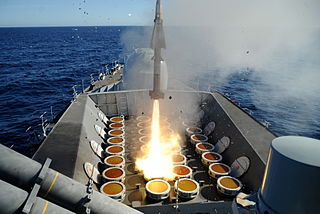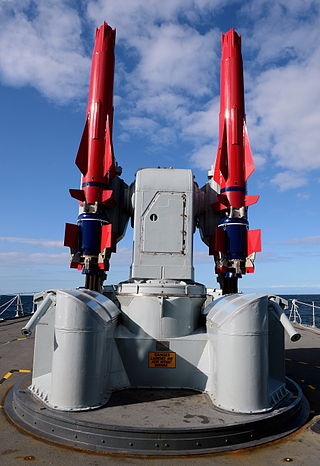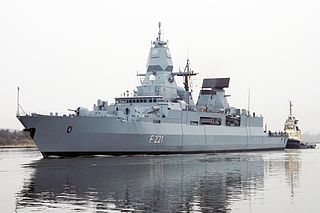
HMS Eagle was an Audacious-class aircraft carrier of the Royal Navy, in service 1951–1972. Until the arrival of the Queen Elizabeth-class aircraft carriers in the 21st century, she and her sister Ark Royal were the two largest Royal Navy aircraft carriers ever built.

Sea Wolf is a naval surface-to-air missile system designed and built by BAC, later to become British Aerospace (BAe) Dynamics, and now MBDA. It is an automated point-defence weapon system designed as a short-range defence against both sea-skimming and high angle anti-ship missiles and aircraft. The Royal Navy has fielded two versions, the GWS-25 Conventionally Launched Sea Wolf (CLSW) and the GWS-26 Vertically Launched Sea Wolf (VLSW) forms. In Royal Navy service Sea Wolf is being replaced by Sea Ceptor.

Sea Dart, or GWS.30 was a Royal Navy surface-to-air missile system designed in the 1960s and entering service in 1973. It was fitted to the Type 42 destroyers, Type 82 destroyer and Invincible-class aircraft carriers of the Royal Navy. Originally developed by Hawker Siddeley, the missile was built by British Aerospace after 1977. It was withdrawn from service in 2012.
Taihō was an aircraft carrier of the Imperial Japanese Navy during World War II. Possessing heavy belt armor and featuring an armored flight deck, she represented a major departure from prior Japanese aircraft carrier design and was expected to not only survive multiple bomb, torpedo, or shell hits, but also continue fighting effectively afterwards.

Naval Tactical Data System (NTDS) was a computerized information processing system developed by the United States Navy in the 1950s and first deployed in the early 1960s for use in combat ships. It took reports from multiple sensors on different ships and collated it to produce a single unified map of the battlespace. This information could then be relayed back to the ships and to the weapons operators.

The Type 61 Salisbury class was a class of the Royal Navy aircraft direction (AD) frigate, built in the 1950s. The purpose of the aircraft direction ships was to provide radar picket duties at some distance from a carrier task force and offer interception guidance to aircraft operating in their area.

The F124 Sachsen class is the German Navy's latest class of air-defense frigates. The design of the hull is based on that of the F123 Brandenburg class but with enhanced stealth features designed to deceive an opponent's radar and acoustic sensors. The class incorporates an advanced multifunction radar APAR and a SMART-L long-range radar which is purported to be capable of detecting stealth aircraft and stealth missiles.

The SCR-584 was an automatic-tracking microwave radar developed by the MIT Radiation Laboratory during World War II. It was one of the most advanced ground-based radars of its era, and became one of the primary gun laying radars used worldwide well into the 1950s. A trailer-mounted mobile version was the SCR-784.

An airport surveillance radar (ASR) is a radar system used at airports to detect and display the presence and position of aircraft in the terminal area, the airspace around airports. It is the main air traffic control system for the airspace around airports. At large airports it typically controls traffic within a radius of 60 miles (96 km) of the airport below an elevation of 25,000 feet. The sophisticated systems at large airports consist of two different radar systems, the primary and secondary surveillance radar. The primary radar typically consists of a large rotating parabolic antenna dish that sweeps a vertical fan-shaped beam of microwaves around the airspace surrounding the airport. It detects the position and range of aircraft by microwaves reflected back to the antenna from the aircraft's surface. The secondary surveillance radar consists of a second rotating antenna, often mounted on the primary antenna, which interrogates the transponders of aircraft, which transmits a radio signal back containing the aircraft's identification, barometric altitude, and an emergency status code, which is displayed on the radar screen next to the return from the primary radar.

The Type 730 is a Chinese seven-barrelled 30 mm Gatling gun/rotary cannon CIWS. It has a PLA Navy designation H/PJ12. It is mounted in an enclosed automatic turret and directed by radar, and electro-optical tracking systems. The maximum rate of fire is 5800 rd/m, and the effective range is up to 3 km.

The AN/SPS-48 is a US naval electronically scanned array, air search three-dimensional radar system manufactured by ITT Exelis and deployed in the 1960s as the primary air search sensor for anti-aircraft warships. The deployment of the AN/SPY-1 and the end of the Cold War led to the decommissioning of many such ships, and many of these vessel's AN/SPS-48 sets were reused on aircraft carriers and amphibious ships where it is used to direct targets for air defense systems such as the Sea Sparrow and RIM-116 SAM missiles. Existing sets are being modernized under the ROAR program to AN/SPS-48G standard for better reliability and usability.
Track-while-scan (TWS) is a mode of radar operation in which the radar allocates part of its power to tracking a target or targets while part of its power is allocated to scanning. It is similar to but functions differently in comparison to its counterparts range-while-search (RWS), long range search (LRS), air combat mode (ACM), velocity search with ranging (VSR) and combined radar mode (CRM). In track-while-scan mode the radar has the ability to acquire and lock/track multiple targets while simultaneously providing a view of the surrounding airspace, which in turn aids the pilot and or operator in maintaining better situational awareness.
Radar in World War II greatly influenced many important aspects of the conflict. This revolutionary new technology of radio-based detection and tracking was used by both the Allies and Axis powers in World War II, which had evolved independently in a number of nations during the mid 1930s. At the outbreak of war in September 1939, both the United Kingdom and Germany had functioning radar systems. In the UK, it was called RDF, Range and Direction Finding, while in Germany the name Funkmeß (radio-measuring) was used, with apparatuses called Funkmessgerät . By the time of the Battle of Britain in mid-1940, the Royal Air Force (RAF) had fully integrated RDF as part of the national air defence.

The Type 271 was a surface search radar used by the Royal Navy and allies during World War II. The first widely used naval microwave-frequency system, it was equipped with an antenna small enough to allow it to be mounted on small ships like corvettes and frigates, while its improved resolution over earlier radars allowed it to pick up a surfaced U-boat at around 3 miles (4.8 km) and its periscope alone at 900 yards (820 m).
The Comprehensive Display System (CDS) was a command, control, and coordination system of the British Royal Navy (RN) that worked with the detection/search Type 984 radar. The system was installed on a total of six ships starting in 1957. The US Navy purchased a prototype CDS and produced twenty of their own version, the Electronic Data System (EDS). These were used on a number of ships until 1968. A modified version, the Data Handling System, was used with the AMES Type 82 radar by the Royal Air Force, and US Air Force very nearly used it as well.

AIRPASS was a British aircraft interception radar and fire-control radar system developed by Ferranti. It was the world's first airborne monopulse radar system and fed data to the world's first head-up display. The name is an acronym for "Aircraft Interception Radar and Pilot's Attack Sight System". In the Royal Air Force (RAF) it was given the official name Radar, Aircraft Interception, Mark 23, normally shortened to AI.23. AIRPASS was used on the English Electric Lightning throughout its lifetime.

The Type 277 was a surface search and secondary aircraft early warning radar used by the Royal Navy and allies during World War II and the post-war era. It was a major update of the earlier Type 271 radar, offering much more power, better signal processing, new displays, and new antennas with greatly improved performance and much simpler mounting requirements. It allowed a radar with performance formerly found only on cruisers and battleships to be fitted even to the smallest corvettes. It began to replace the 271 in 1943 and was widespread by the end of the year.

The AMES Type 82, also widely known by its rainbow codename Orange Yeoman, was an S-band 3D radar built by the Marconi Company and used by the Royal Air Force (RAF), initially for tactical control and later for air traffic control (ATC).

The AMES Type 80, sometimes known by its development rainbow code Green Garlic, was a powerful early warning (EW) and ground-controlled interception (GCI) radar developed by the Telecommunications Research Establishment (TRE) and built by Decca for the Royal Air Force (RAF). It could reliably detect a large fighter or small bomber at ranges over 210 nautical miles, and large, high-flying aircraft were seen out to the radar horizon. It was the primary military ground-based radar in the UK from the mid-1950s into the late 1960s, providing coverage over the entire British Isles.

The AMES Type 85, also known by its rainbow code Blue Yeoman, was an extremely powerful early warning (EW) and fighter direction (GCI) radar used by the Royal Air Force (RAF) as part of the Linesman/Mediator radar network. First proposed in early 1958, it was eleven years before they became operational in late 1968, by which time they were already considered obsolete. The Type 85 remained the RAF's primary air defense radar until it was replaced by Marconi Martello sets in the late-1980s as part of the new IUKADGE network.
















